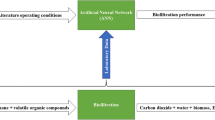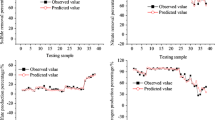Abstract
Based on an experimental database consisting of 194 daily cases, artificial neural networks were used to model the removal efficiency of a biofilter for treating hydrogen sulphide (H2S). In this work, the removal efficiency of the reactor was considered as a function of the changes in the air flow and concentration of H2S entering the biofilter. In order to obtain true representative values, the removal efficiencies (outputs) were measured 24 h after each input was changed. A MLP (multilayer perceptron 2-2-1) model with two input variables (unit flow and concentration of the contaminant fed into the biofilter) rendered good prediction values with a determination coefficient of 0.92 for the removal efficiency within the range studied. This means that the MLP model can explain 92% of the overall variability detected in the biofilter corresponding to a wide range of operating conditions.




Similar content being viewed by others
Abbreviations
- ANN:
-
Artificial neural network
- b 1 and b 0 :
-
Slope and intercept, respectively, of a least-squares regression between the predicted and observed data
- C :
-
Concentration of H2S fed to the reactor
- d :
-
Index of agreement
- RE:
-
Removal efficiency
- FA2:
-
Fraction of two
- MLR:
-
Multiple linear regression
- MLP:
-
Multilayer perceptron
- Q u :
-
Unit flow
- R :
-
Pearson correlation coefficient
- R 2 :
-
Determination coefficient
- R m :
-
Ratio of means
- RMSE:
-
Total root mean squared error
- R st :
-
The ratio of the systematic error component to total RMSE
References
van Groenestijn JW, Kraakman NJR (2005) Recent developments in biological waste gas purification in Europe. Chem Eng J 113(2–3):85–91
Deshusses MA, Johnson C (2000) Development and validation of a simple protocol to rapidly determine the performance of biofilters for VOC treatment. Environ Sci Technol 34:461–467
Chmiel K, Konieczny A, Palica M, Jarzebski AB (2005) Periodic operation of biofilters. A concise model and experimental validation. Chem Eng Sci 60:2845–2850
Morales M, Hernández S, Cornabé T, Revah S, Auria R (2003) Effect of drying on biofilter performance: modeling and experimental approach. Environ Sci Technol 37:985–992
Alonso C, Sudian MT, Sorial GA, Smith FL, Biswas P, Smith PJ, Brenner RC (1997) Gas treatment in trickle-bed biofilters: biomass, how much is enough? Biotechnol Bioeng 54(6):583–594
Alonso C, Suidan MT, Kim BR, Kim BJ (1998) Dynamic mathematical model for the biodegradation of VOCs in a biofilter: biomass accumulation study. Environ Sci Technol 31:3118–3123
Delhoménie MC, Bibeau L, Gendron J, Brzezinski R, Heitz M (2003) A study of clogging in a biofilter treating toluene vapors. Chem Eng J 94:211–222
Iliuta I, Larachi F (2004) Transient biofilter aerodynamics and clogging for VOC degradation. Chem Eng Sci 59:3293–3302
Zarook S, Shaikh AA, Ansar Z (1997) Development, experimental validation and dynamic analysis of a general transient biofilter model. Chem Eng Sci 52:759–773
Schwarz BCE, Devinny JS, Tsotsis TT (2001) A biofilter network model—importance of the pore structure and other large-scale heterogeneities. Chem Eng Sci 56:475–483
Gerrard AM, Misiaczek O, Hajkova D, Halecky M, Paca J (2005) Steady state models for the biofiltration of styrene/air mixtures. Chem Biochem Eng Q 19(2):185–190
Spigno G, Zilli M, Nicolella C (2004) Mathematical modelling and simulation of phenol degradation in biofilters. Biochem Eng J 19:267–275
Devinny JS, Ramesh J (2005) A phenomenological review of biofilter models. Chem Eng J 113:187–196
Elias A, Ibarra-Berastegi G, Ormazabal J, Murgia I, Zugazti P (1996) ADM: a model for water treatment in an anaerobic biological reactor. In: Development and application of computer techniques to environmental studies VI. III, CMP. WIT, Southampton, pp 153–162
Liu G, Mi Z (2004) Prediction of pulsation frequency of pulsing flow in trickle-bed reactors using artificial neural network. Chem Eng Sci 59:5787–5794
Steyer JP, Harmand J (2003) Fault detection and isolation in wastewater treatment plants: comparison of different approaches and experimental results. In: Agathos SN, Reineke W (eds) Biotechnology for the environment: wastewater treatment and modelling, waste gas handling, Kluwer Academic Publishers, Dordrecht, vol. 3C, pp 87–100
Strik DPBTB, Domnanovich AM, Zani L, Braun R, Holubar P (2005) Prediction of trace compounds in biogas from anaerobic digestion using the MATLAB Neural Network Toolbox. Environ Model Softw 20:803–810
Hodgson BJ, Taylor CN, Ushio M, Leigh JR, Kalganova T, Baganz F (2004) Intelligent modelling of bioprocesses: a comparison of structured and unstructured approaches. Bioprocess Biosyst Eng 26:353–359
Maier R, Dandy GC (2000) Neural networks for the prediction and forecasting of water resources variables: a review of modelling issues and applications. Environ Model Softw 15:101–124
Gardner MW, Dorling R (1998) Artificial neural networks (the multilayer perceptron). A review of applications in the atmospheric sciences. Atmos Environ 32:2627–2636
Masters T (1993) Practical neural network recipes in C++. Academic, San Diego
Maier HR, Morgan N, Chow CWK (2004) Use of artificial neural networks for predicting optimal alum doses and treated water quality parameters. Environ Model Softw 19:485–494
Bowden G, Maier HR, Dandy GC (2001) Optimal division of data for neural network models in water resources applications. Water Resour Res 38:21–28
Elías A, Barona A, Arreguy A, Ríos J, Aranguiz I, Peñas J (2002) Evaluation of a packing material for the biodegradation of H2S and product analysis. Process Biochem 37:813–820
Barona A, Elías A, Arias R, Cano I, Gonzalez R (2004) Effect of sudden variations in operating conditions on biofilter performance. Biochem Eng J 22(1):25–31
Barona A, Elias A, Amurrio A, Cano I, Arias R (2005) Hydrogen sulphide adsorption on a waste material used in bioreactors. Biochem Eng J 24:79–86
Willmott CJ (1981) On the validation of models. Phys Geogr 2:184–194
Willmott CJ (1982) Some comments on the evaluation of model performance. Bull Am Meteorol Soc 63:1309–1313
Willmott CJ, Ackleson SG, Davis RE, Feddema JJ, Klink KM, Legates DR, O’Donnell J, Rowe MC (1985) Statistics for the evaluation and comparison of models. J Geophys Res 90:8995–9005
Hanna SR, Strimaitis DG, Chang JC (1991) User’s guide for software for evaluating hazardous gas dispersion models. American Petroleum Institute, Washington
Comrie A (1997) Comparing neural networks and regression models for ozone forecasting. J Air Waste Manag Assoc 47:653–663
Hunter A, Kennedy L, Henry J, Ferguson RI (2000) Application of neural networks and sensitivity analysis to improved prediction of trauma survival. Comput Methods Algorithms Biomed 62:11–19
Wilks DS (1995) Statistical methods in the atmospheric sciences. Academic, San Diego
Acknowledgements
The authors wish to thank the Basque Government (BERRILUR project No. IE03-110), the Spanish Government (MCYT PPQ2002-01088 with FEDER funding) and the University of the Basque Country (UPV 00149.345-E-15398/2003 project) for the financial support to develop this research. Special thanks are given to the EUVE for the lab-scale pilot plant simulation.
Author information
Authors and Affiliations
Corresponding author
Rights and permissions
About this article
Cite this article
Elías, A., Ibarra-Berastegi, G., Arias, R. et al. Neural networks as a tool for control and management of a biological reactor for treating hydrogen sulphide. Bioprocess Biosyst Eng 29, 129–136 (2006). https://doi.org/10.1007/s00449-006-0062-3
Received:
Accepted:
Published:
Issue Date:
DOI: https://doi.org/10.1007/s00449-006-0062-3




